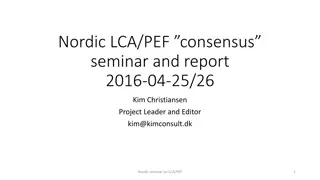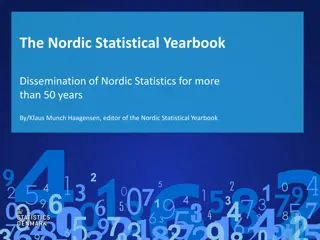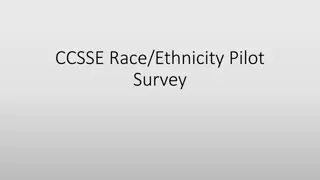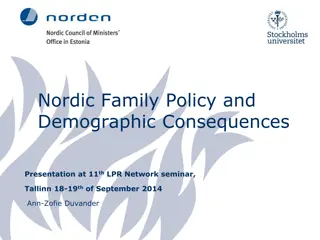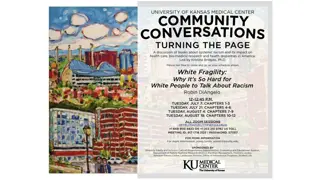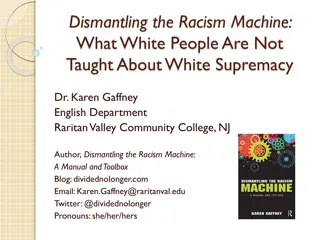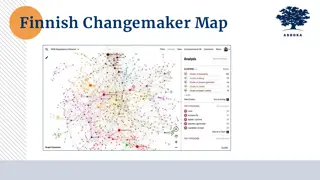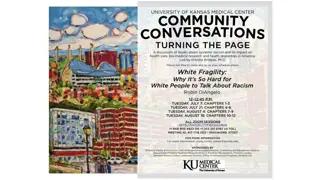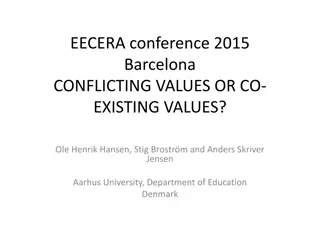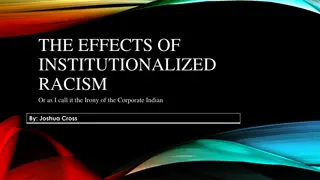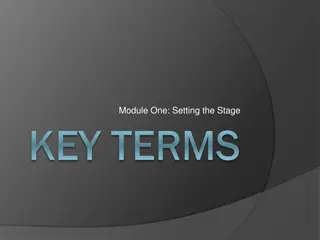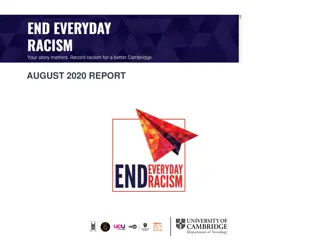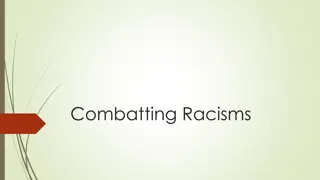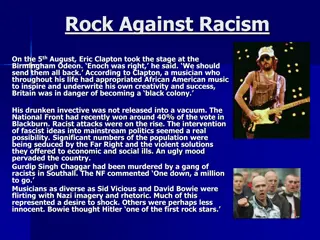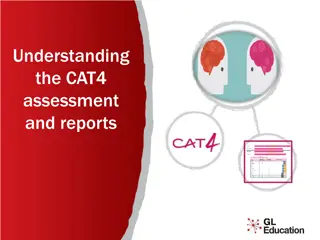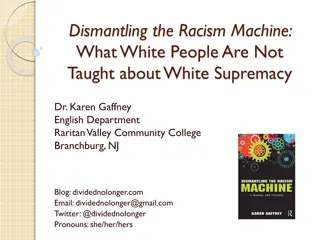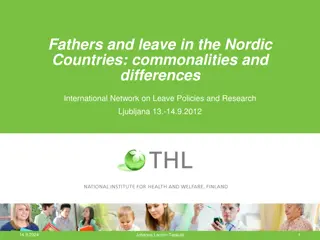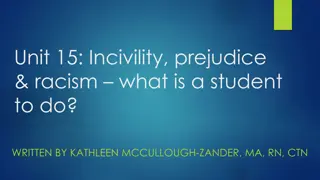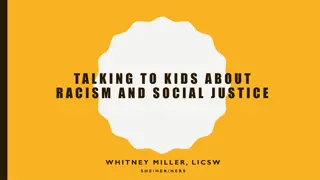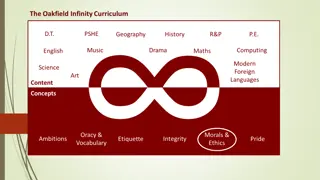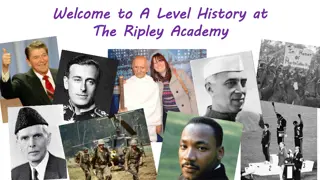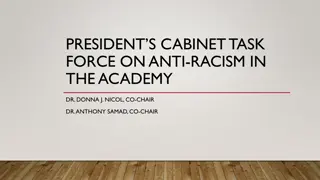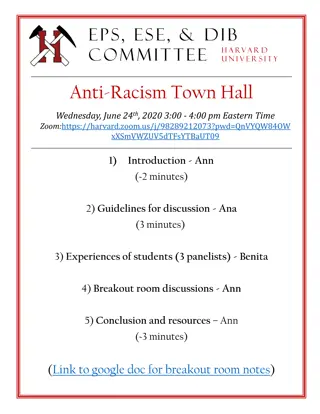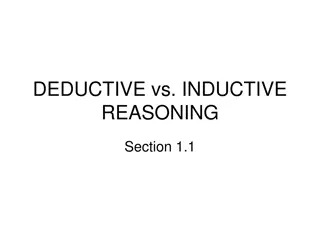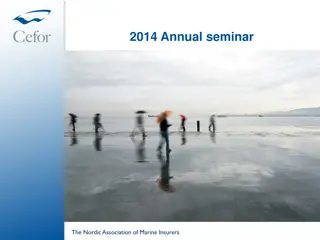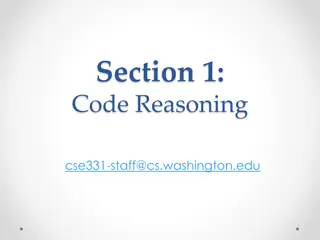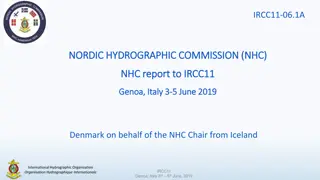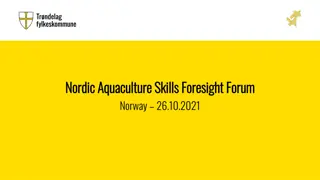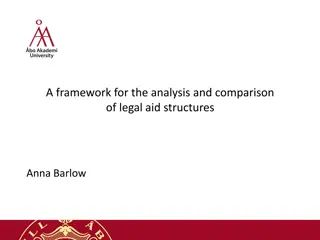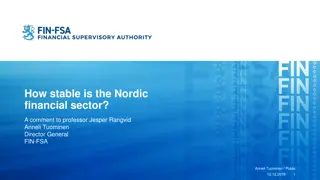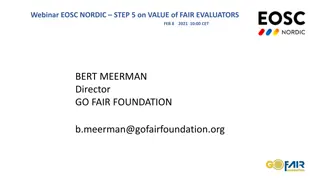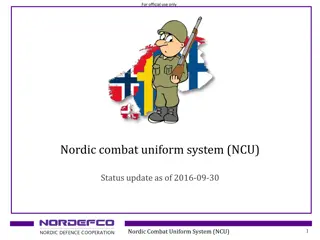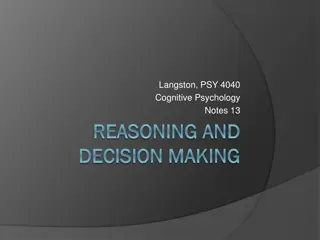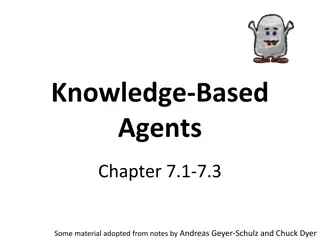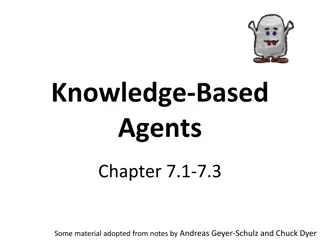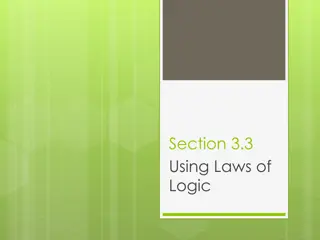Nordic Exclusionary Reasoning and Racism: Understanding the Challenges
This content explores the issues of racialization and exclusionary reasoning in the Nordic countries, shedding light on the complexities of racism, entitlement, and perceptions towards different groups. Through discussions on images, blog posts, and societal attitudes, it delves into the nuances of cultural interactions and biases. Insights from academics, such as Peter Hervik and Susan Sontag, provide valuable perspectives on how images and discourse shape our understanding of race and identity.
Download Presentation

Please find below an Image/Link to download the presentation.
The content on the website is provided AS IS for your information and personal use only. It may not be sold, licensed, or shared on other websites without obtaining consent from the author. Download presentation by click this link. If you encounter any issues during the download, it is possible that the publisher has removed the file from their server.
E N D
Presentation Transcript
+ On the Challenge of Making Sense of Nordic Exclusionary Reasoning Racialization in the Nordic Countries , University of Jyv skul Peter Hervik, professor Center for the Study of Migration and Diversity (CoMID) hervik@cgs.aau.dk 4 November 2015
+Politiken 4 August 2011, Wulffmorgenthaler 2
+Susan Sontag 3 Instead of exlusive focusing on the objectivity and accuracy of an image to the object being represented, we suggest that the significance or impact of images may lie simply in our relationship to them: the way we consume them, forward them to friends or family, and edit and recontextualize them ourselves
+ 4 Souvenirs Circulating pictures; it was all fun Perhaps torture is more attractive, as something to record, when it has a sexual component
+Entitlement Racism (Essed 2013, ENAR) 5 The perpetrators know, or could have known that their portrayals are offensive, but they do not see any reason to apologize or change their behaviour They insist on the right to offend in the name of freedom, regardless of its impact on others At the core of racism is the humiliation of the other in order to elevate the self
+Case 1. Blog related to tabloid- newspaper 6 Radical Islam must be fought by several groups. It would do the debate on Islam good, if left-wingers and feminists would dare to object. Incident One: 18 year old Somali rapist Incident Two: External examiner in high-school who refuses to greet female students
+ 7 Refugees are welcome, stop Muslims (maxp, 19 June 2013) Obviously, there is much between a handshake to the Paedophile Somali rapist from Gullestrup, but everything begins with a detail (Henrik D., 10 June 2013) If you are a Muhammedanian, then you have taken the whole package (Henrik D., 10 June 2013) We are in the process of a destruction of the European culture (Rasmus, 20 June 2013)
+Case 2. Public Radio website 8 Drunk Student: Do I need to be sober at Hassan's place Sarah: The 10 immigrants in the class do not want drinking in their houses, so we cannot drink alkohol until after 8pm
+ 9 Nobody should change Danish culture (including drinking) Religion does not come first in this country They have to bear the consequences Then they cannot participate They can do what they want
+ 10 Facts that are inconsistent with the ideological scheme either go unnoticed or get explained away (Gal 2005: 38). Elements that do not fit its interpretive structure that cannot be seen to fit must be either ignored or transformed (ibid.)
+Silent racism 11 Silent racism refers to unspoken negative thoughts, emotions, and attitudes regarding African Americans and other people of color that dwell in the minds of white people (Barbara Trepagnier 2001)
+Silent racism is also close to Everyday racism (Philomena Essed) 12 Everyday racism refers to routine actions that go unquestioned by members of the dominant group which in some way discriminate against members of a racial or ethnic category (Essed 1991). Silent racism differs from everyday racism in that silent racism refers solely to the thoughts, beliefs, and emotions white people have concerningAfrican Americans and other people of color, not to discriminatory statements or actions taken against them
+Silent racism corresponds to White privilege (David Wellman) 13 Wellman maintains that the rationale used by white people to justify their relative location to blacks in society is due to the preservation of privilege (1977 & 1993) By definition, people who defend white privilege attempt to maintain the racial formation, not change it
+Susan Gal & Judith Irvine 14 Fractal recursions are similarities between contrasts made at different scales, while differences are ignored (2000: 27) Fractual recursions involve the projection of an opposition, salient at some level of relationship onto some other level
+Comments on blogs and webnews 15 Time and again the authors construct categories of people, who are criticized for their tolerance , historical openness , naivety , and humanitarian points of view, while they make strong calls for more authoritarianism , firmness , guts and punishments
+(Neo)Racism 16 a scavenger ideology, which gains its power from its ability to pick out and utilize ideas and values from other sets of ideas and beliefs in specific socio-historical contexts (Solomos and Back, 1996) and assigning qualities to social groups that are fixed, made natural and confined within a pseudo-biologically defined culturalism (Barker 1981).
+Culture Conflict 17 As political and social hostility rooted in different systems of moral understanding. Competing systems of moral understanding are by no means trifling, but always have a character of ultimacy to them. They are not merely attitudes that can change on a whim but basic commitments and beliefs that provide a source of identity, precisely this reason that political action rooted in these principles and ideals tends to be so passionate. (Hunter 1991)
+Narcissism (Freud 1930) 18 - pathological focus on small differences between self and someone very close - creating distance between self and other - tokens of an uncertain self
+The psychoanalytic notion of projective Chimera (as enemy image) 19 Tied to psychoanalytical projection: seeing in others that which one does not wish to become conscious of in oneself (Smith 1999:218) the totalitarian character cannot admit admit to itself this wish for destruction, it projects the wish onto others, above all, the enemy which it has chosen, invented, or which has been invented for it by others, an enemy that is always imagined as inferior, just as it is dangerous. Fables of conspiracies and other evil things are spread out (Horkheimer quoted in Smith)
+ 20 Self-regard depends upon and in turn exacerbates intolerance. The particular property of the narcissist gaze is that it glances up at the Other only to confirm its difference. Does not engage itself with the Other in any real sense. Narcissism is uninterested in others except to the extent that they reflect back upon himself. What is different is rejected if it fails to confirm the narcissist in his self-opinion.
+AppaduraisPredatory narcissism (2006 Fear of Small Numbers) 21 Elimination of difference itself
+Predatory identities 22 Those identities whose social construction and mobilization require the extinction of other, proximate social categories, defined as threats to the very existence of some group, defined as a we Methods: - Portraying oneself as a threatened majority - We could beocme a minority in our own country
+Tipping Points: 23 Capture of the state by racist/natinalist parties/groups 1) Census tools and techniques and their ethnicized interpretation 2) Felt lack of fit between political and ethnic borders 3) Campaigns of fear 4) Fear of small numbers 5)
+Freud quoted in Ignatieff (p 48) 24 it is precisely the minor differences in people who are otherwise alike that form the basis of feelings of strangeness and hostility between them It is precisely because the differences between groups are minor that they much be expressed aggressively. The less substantial the differences between two groups, the more they both struggle to portray those differences as absolute it would be tempting to pursue this idea and to derive from this narcissism of minor differences the hostility which in every human relation we see fighting against feelings of fellowship and overpowering the commandment that all men should love one another. (Ignatieff 1998 Warrior s Honor
+Nationalism is a kind of narcisissm 25 A nationalist takes the neutral facts about a people their language, habitat, culture, tradition, and history and turns these facts into a narrative, whose purpose is to illuminate the self- consciousness of a group, to enable them to think of themselves as a nation with a claim to self-determination. A nationalist, in other words, takes minor differences - indifferent in themselves and transforms them into major differences. So traditions are invented (p 50)
+ 26 The problem with nationalism is not the desire for self- determination itself, but the epistemological illusion that you can be at home, you can be understood, only among people like yourself ... What is wrong with nationalism is not the desire to be master in your own house, but the conviction that only people like yourself deserve to be in the house (p 59)
+ 27 The root of intolerance lies in our tendency to overvalue our own identities; by overvalue, I mean we insist that we have nothing in common, nothing to share. At the heart of this insistence lurks the fantasy of purity, of boundaries that can never be crossed. (Ignatieff p62) Or, call it the anxiety of incompleteness , the fear of small numbers
+Anxiety of Incompleteness .. 28 Anxiety and anger are expressed in BLAME Blame is the result of the desire to make the other party responsible Fear follows a similar pattern feeding the idea of defense and feeding the idea of revenge
+Conclusion 29 With the lack of full awareness this is where we find hegemonic representations, those representations of the world that are so habituated, so deeply inscribed in everyday routine, that they may no longer be seen as forms of control or seen at all," (Strauss and Quinn 1997:39).


